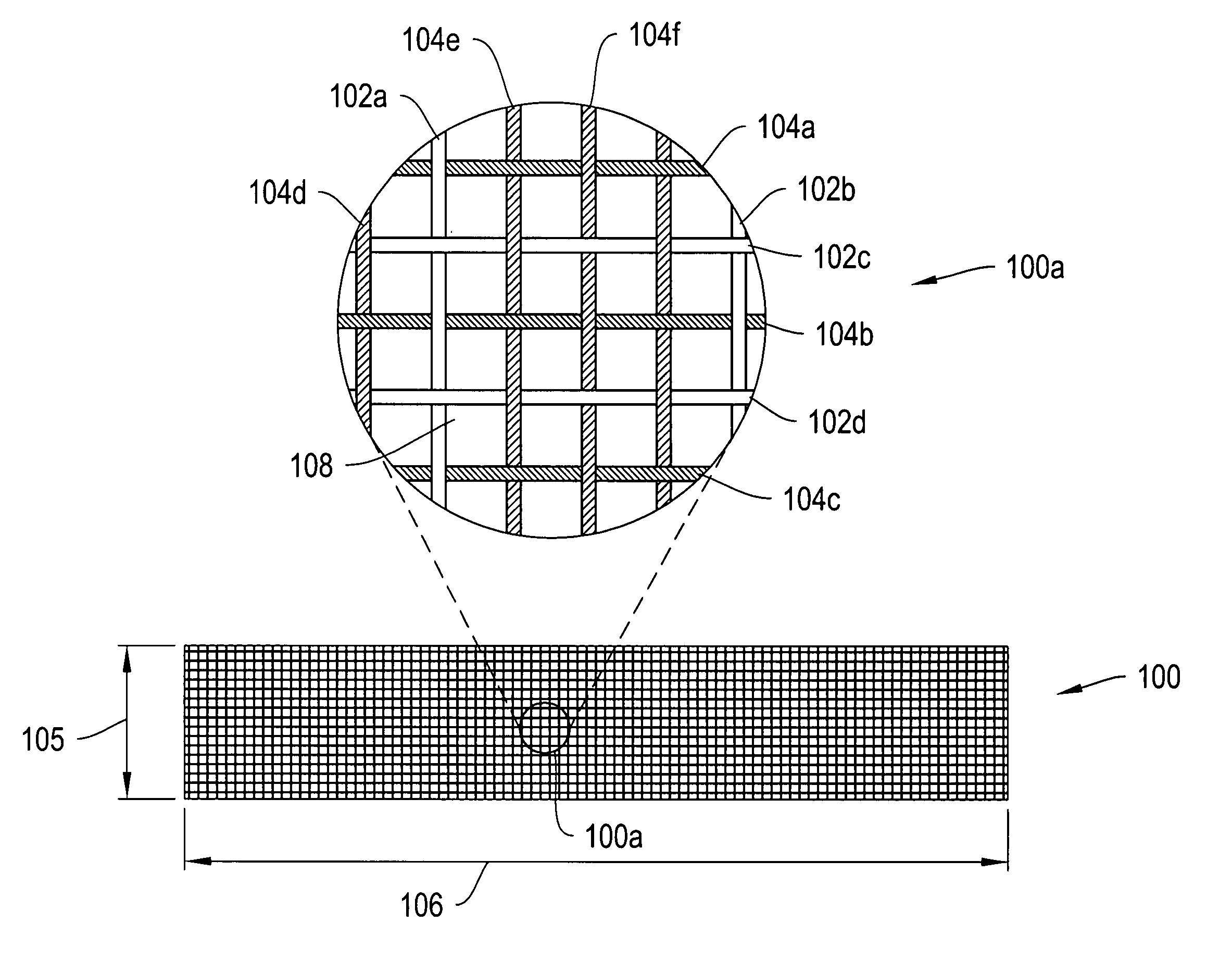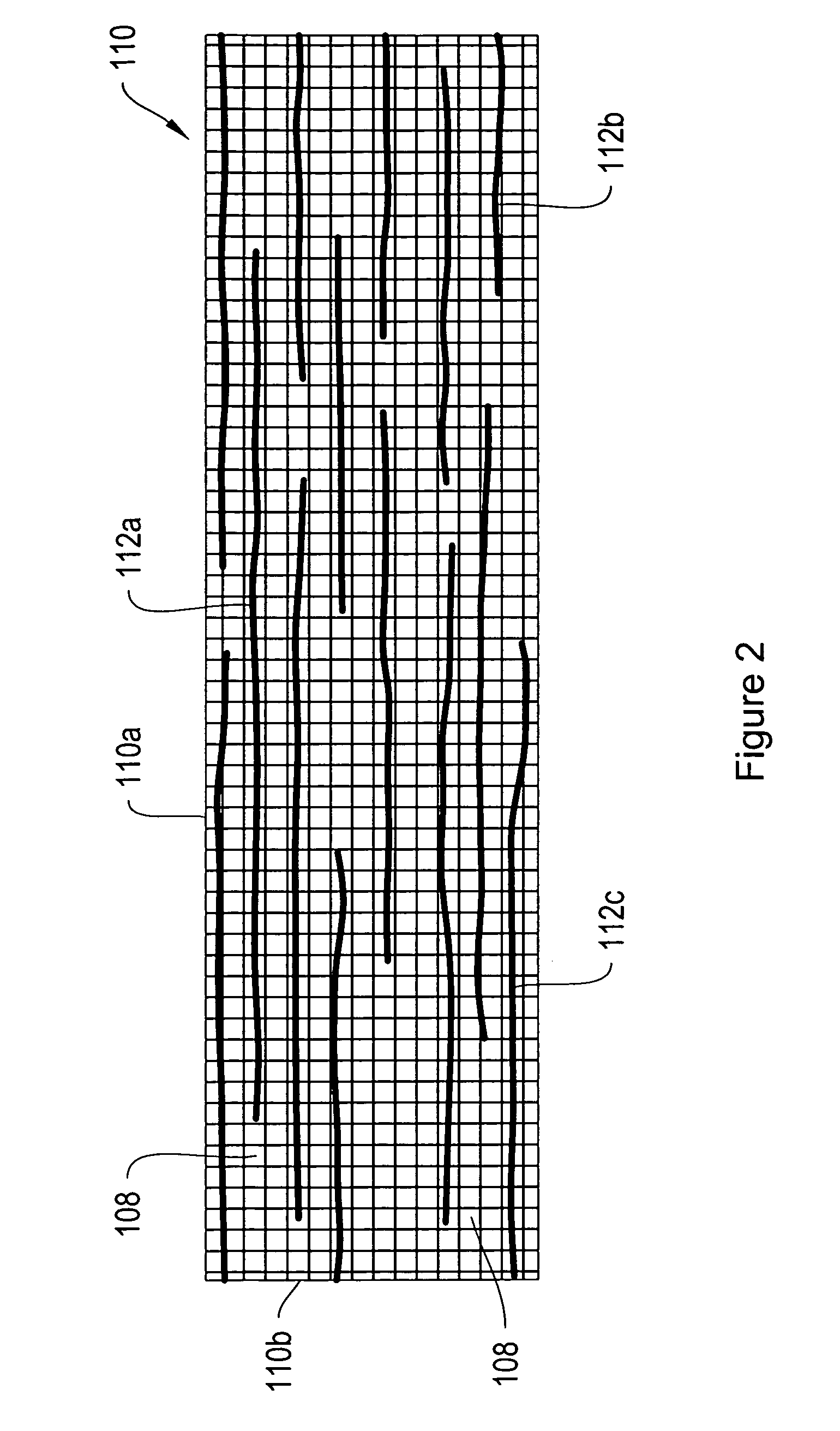[0006]More particularly, in one aspect, the invention provides a mesh sling including a plurality of fibers that are braided, knitted or otherwise woven together. The sling fibers may be formed from one or more filaments, which may be made from one or more materials, or may be formed as monofilaments. According to one embodiment, some of the sling fibers are biodegradable, while others are non-biodegradable. In one configuration, the sling has a high biodegradable / non-biodegradable ratio in a longitudinal direction. One
advantage of this construction is that as the longitudinal fibers degrade, they are replaced with permanent and prominent
scar tissue. Unlike the original sling fibers, the
scar tissue naturally expands and contracts to accommodate physiological changes, such as body growth and patient movement. According to another
advantage of the invention, at least some of the sling fibers are non-biodegradable and remain to enhance the support provided by the scar tissue. In this way, the sling fibers initially provide the needed anatomical support, encourage scar
tissue formation, and ultimately substantially give way to enable the body's natural tissues to provide most of the needed anatomical support.
[0007]In one configuration, the ratio of biodegradable / non-biodegradable fibers in a longitudinal direction (e.g., a direction extending across the urethra as opposed to along the urethra) is greater than about ¼, ⅓, ½, ¾ or 1. In some configurations, the ratio of biodegradable / non-biodegradable fibers in a longitudinal direction is greater than about 2, 3 or 4. According to further configurations, the over all ratio of biodegradable / non-biodegradable fibers is greater than about ¼, ⅓, ½, ¾, 1, 2, 3 or 4.
[0008]According to another embodiment, some of the sling fibers are composite fibers including a non-biodegradable core and an outer biodegradable layer. The composite fibers may be formed, for example, by co-
extrusion or by dipping,
coating or otherwise treating the non-biodegradable core to provide the outer biodegradable layer. The composite fibers may be interleaved with non-biodegradable and / or biodegradable fibers to form a sling for supporting a patient's urethra or for supporting the patient's pelvic floor. One
advantage of the composite fibers is that as the outer layer degrades, the size of the pores / interstitial gaps between the fibers effectively increases, providing more room for tissue in-growth and scar
tissue formation. The composite fibers may be employed as longitudinal and / or transverse fibers in the sling of the invention.
[0009]According to various configurations, the pores / interstitial gaps between adjacent longitudinally extending fibers and / or between adjacent transversely extending fibers are greater than about 50 micrometers (μm), 75 μm, 100 μm, 200 μm or 500 μm subsequent to degradation of the composite
fiber outer layer. According to a further configuration, the fibers used to form the mesh sling have an initial
diameter of between about 0.005 cm and about 0.1 cm. In some instances, the fibers have an initial
diameter of between about 0.01 cm and about 0.05 cm. According to various constructions, the sling may have an initial width of between about 1 cm to about 4 cm, about 4 cm to about 6 cm, about 6 cm to about 8 cm, or larger, depending on the
anatomical location to be supported. The slings of the invention may have an initial length of about 4 cm to about 6 cm, about 6 cm to about 8 cm, about 8 cm to about 12 cm, about 12 cm to about 16 cm, or larger, depending on the
anatomical location to be supported.
[0010]The non-biodegradable portions of the sling may be fabricated from any of a plurality of biocompatible materials, such as nylon,
silicone,
polyethylene,
polyester,
polyethylene,
polyurethane,
polypropylene, polyvinyl polymers, fluoropolymers, copolymers thereof, combinations thereof, or other suitable synthetic material(s). The biodegradable portions of the sling may be derived from
mammalian tissue,
synthetic materials, or a combination of
mammalian tissue and synthetic material. According to some configurations, the biodegradable portions of the sling are formed from synthetic polymers, such as polylatic acid, polyglycolic acid, or
natural polymers, such as collagen,
cellulose, polypeptides, polysaccharides, or copolymers thereof. According to some configurations, bioactive compounds or drugs may be added to the biodegradable polymers to enhance acute
inflammation and encourage scar
tissue formation. Examples of these
inflammation promoters are
fibrinogen and
fibrin.
[0011]The sling may incorporate or be coated with one or more agents to provide a
therapeutic effect, for example, to reduce discomfort, to reduce the chance of infection and / or to promote tissue growth. According to some embodiments, the one or more agents may be disposed between the sling fibers and / or between the two sling
layers.
 Login to View More
Login to View More  Login to View More
Login to View More 


